D-Link AC1750 Wi-Fi Router DIR-1750 Instruction Manual
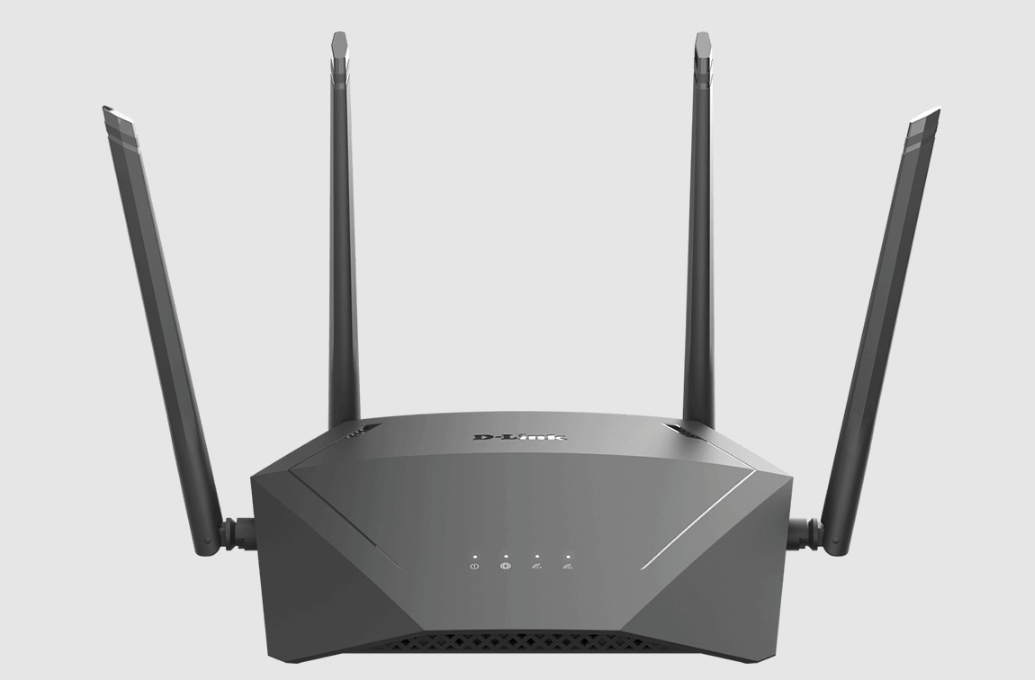
Content
Introduction
High-performance router made for seamless networking in homes and small offices, and it will be covered in this article. The DIR-1750's dual-band technology ensures lag-free streaming, gaming, and surfing by providing fast and dependable internet rates. It's a flexible and safe option for all your connectivity needs with four Gigabit LAN ports, a Gigabit WAN port, and strong security features.
Technical Specifications
Device Interfaces
- Wireless Interface (2.4 GHz): IEEE 802.11n/g/b
- Wireless Interface (5 GHz): IEEE 802.11 ac/n/a
- Four 10/100/1000 Mbps LAN ports
- One 10/100/1000 Mbps WAN port
Antenna Types
- Four external antennas
Standards
- IEEE 802.11ac1,2,3
- IEEE 802.11b
- IEEE 802.11n
- IEEE 802.11a
- IEEE 802.11g
- IEEE 802.3u
- IEEE 802.3ab
- IEEE 802.1p
- IEEE 802.1q
Security
- WPA/WPA2-Personal
- Wi-Fi Protected Setup (WPS)
Power
- Input: 100 to 240 V AC, 50 / 60 Hz
- Output: 12 V, 1.5 A
Temperature
- Operating: 0 to 40 °C (32 to 104 °F)
- Storage: -20 to 65 °C (-4 to 149 °F)
Humidity
- Operating: 10% to 90% maximum, non-condensing
- Storage: 5% to 95% maximum, non-condensing
Certifications
- IC
- FCC
- CE
Dimensions
- L x W x H: 226 x 173 x 52 mm (8.9 x 6.8 x 2.0 in)
Weight
- 414 g (0.91 lbs)
Product Overview
Package Contents
| Item | Included |
|---|---|
| DIR-1750 | V |
| DIR-1750 V | V |
| Quick Installation Guide | V |
| Quick Installation Card | V |
| Ethernet Cable (RJ45) | V |
| Power Adapter | V |
If any of the above items are missing or damaged, please contact your local reseller.
Note: Using a power supply with a different voltage rating than the one included with the router will cause damage and void the warranty for this product.
Features
Need super-fast Wi-Fi for your wire-free, all-streaming house? With a powerful dual-core processor, the AC1750 Gigabit Wi-Fi Router packs in enough processing power to handle every networking task you throw at it. It’s a powerful, intelligent home router with integrated voice assistant compatibility for Amazon Alexa and Google Assistant so you can control your network with voice commands.
- Handle More with a High-Power Processor
With the DIR-1750, you’re not only enjoying buffer-free gaming and lightning fast surfing, you’re also enjoying features such as an optimizing QoS, an automatic firmware update system that ensures the latest features, and compatibility with voice assistants. All this is possible with the router’s 1.25 GHz dual-core high-power processor, 128 MB of flash memory and 128 MB of RAM. - Enhanced Quality of Service Features
The built-in Quality of Service (QoS) engine allows you to prioritize important traffic to ensure that your favorite applications are receiving optimal bandwidth. - Always Up-to-Date with the Latest Features
The DIR-1750 will automatically check daily for updates to make sure that the device always has the latest features, and will install the update silently in the background. For an extra peace of mind, in the event of failure during the firmware update, the router will store a backup system image in the memory before proceeding with the update. - Easy to Set Up and Manage
Sharing your Internet connection doesn’t have to be a complicated process; just download the free D-Link Wi-Fi app for your mobile device and follow the on-screen step-by-step instructions to set up your DIR-1750. You also have the option to use a web browser to access the setup wizard and to manage your router. Support for industry-standard Wi-Fi Protected Setup (WPS) lets you create encrypted connections to new devices by pressing a button.
System Requirements
| Network Requirements |
|---|
| • An Ethernet-based cable, DSL or fiber modem |
| • IEEE 802.11ac/n/g/b/a wireless clients |
| • 10/100/1000 Ethernet |
| Web-based Configuration Utility Requirements |
|---|
| Computer with the following: |
| • Windows®, Macintosh, or Linux-based operating system |
| • An installed Ethernet adapter |
| Browser Requirements: |
| • Internet Explorer 10 or higher |
| • Firefox 28 or higher |
| • Safari 6 or higher |
| • Chrome 28 or higher |
| Windows® Users: Make sure you have the latest version of Java installed. Visit https://www.java.com to download the latest version. |
| D-Link Wi-Fi App Requirements |
|---|
| • iOS® or Android™ device (Please refer to the app's store page to check whether your device is compatible.) |
Hardware Overview
LED Indicators

| LED Indicator | Status | Description |
|---|---|---|
| 1 Power | Solid White | The device is on and the system is healthy. |
| Solid Orange | The device is booting up or performing the factory reset process. | |
| Blinking Orange | The device is under recovery mode. | |
| 2 Internet | Solid White | The Internet port connection is established. |
| Solid Orange | The device cannot connect to the Internet. | |
| Blinking Orange | The device is undergoing the firmware upgrade process. | |
| 3 Wireless (2.4 GHz) | Solid White | The 2.4 GHz wireless band is enabled. |
| Blinking White | The device is processing WPS. | |
| 4 Wireless (5 GHz) | Solid White | The 5 GHz wireless band is enabled. |
| Blinking White | The device is processing WPS. |
Back Panel
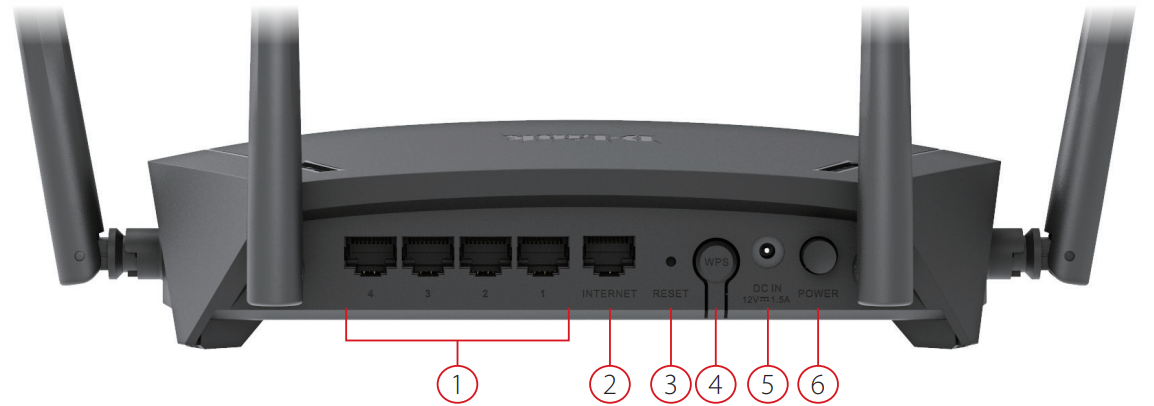
DIR-1750 Ports and Buttons
| Port/Button | Description |
|---|---|
| 1 Gigabit LAN Ports (1-4) | Connect Ethernet devices such as computers, switches, storage (NAS) devices, and game consoles. |
| 2 Gigabit WAN Port | Using an Ethernet cable, connect your broadband modem to this port. |
| 3 Reset Button | Insert a paperclip in the hole, wait for 10 seconds, and release to reset the router to default settings. |
| 4 WPS Button | Press to start the WPS process and automatically create an encrypted connection to a WPS client. |
| 5 Power Connector | Connector for the supplied power adapter. |
| 6 Power Button | Press the power button to power the device on or off. |
Installation
Before you Begin
- Placement of the router is very important. Do not place the router in an enclosed area such as a closet, cabinet, attic, or garage.
- Configure the router with the computer that was last connected directly to your Internet connection. Verify that it is connected to the Internet before connecting additional devices.
- If your ISP provided you with a modem/router combo, you will need to set it to “bridge” mode so the router can work properly. Please contact your ISP or refer to the user manual for your modem/router device.
- You can only use the Ethernet port on your modem. If you were using the USB connection before using the router, then you must turn off your modem, disconnect the USB cable and connect an Ethernet cable to the Internet port on the router, and then turn the modem back on. In some cases, you may need to call your Internet Service Provider (ISP) to change connection types (USB to Ethernet).
- If connecting to a DSL modem, make sure to have your DSL service information provided by your Internet Service Provider handy. This information is likely to include your DSL account's Username and Password. Your ISP may also supply you with additional WAN configuration settings which might be necessary to establish a connection.
- If you are connecting a considerable amount of networking equipment, it may be a good idea to take the time to label each cable or take a picture of your existing setup before making any changes.
- If you have DSL and are connecting via PPPoE, make sure you disable or uninstall any PPPoE software such as WinPoET, BroadJump, or EnterNet 300 from your computer or you will not be able to connect to the Internet.
Wireless Installation Considerations
The D-Link wireless router lets you access your network using a wireless connection from virtually anywhere within the operating range of your wireless network. Keep in mind that the number, thickness and location of walls, ceilings, or other objects that the wireless signals must pass through may limit the range. Typical ranges vary depending on the types of materials and background RF (radio frequency) noise in your home or business. The key to maximizing wireless range is to follow these basic guidelines:
- Keep the number of walls and ceilings between the D-Link router and other network devices to a minimum - each wall or ceiling can reduce your adapter’s range from 3-90 feet (1-30 meters.) Position your devices so that the number of walls or ceilings is minimized.
- Be aware of the direct line between network devices. A wall that is 1.5 feet thick (0.5 meters), at a 45-degree angle appears to be almost 3 feet (1 meter) thick. At a 2-degree angle it looks over 42 feet (14 meters) thick. Position devices so that the signal will travel straight through a wall or ceiling (instead of at an angle) for better reception.
- Building materials make a difference. A solid metal door or aluminum studs may have a negative effect on range. Try to position access points, wireless routers, and computers so that the signal passes through drywall or open doorways. Materials and objects such as glass, steel, metal, walls with insulation, water (fish tanks), mirrors, file cabinets, brick, and concrete will degrade your wireless signal.
- Keep your product away (at least 3-6 feet or 1-2 meters) from electrical devices or appliances that generate RF noise.
- If you are using 2.4 GHz cordless phones, your wireless connection may degrade dramatically or drop completely. Make sure your 2.4 GHz phone base is as far away from your wireless devices as possible. The base transmits a signal even if the phone is not in use.
Setup
There are several different ways you can configure your router to connect to the Internet
- D-Link Wi-Fi App - Use your compatible Android or iOS device to install and configure your router. Refer to D-Link Wi-Fi App Setup on page 9.
- Hardware Setup - This section explains how to setup your DIR-1750. Refer to Hardware Setup on page 11.
- D-Link Setup Wizard - This wizard will launch when you log into the router by using your PC for the first time. Refer to Setup Wizard on page 14.
- Manual Setup - Log in to the router to manually configure your router. Refer to Configuration on page 21
D-Link Wi-Fi App Setup
The D-Link Wi-Fi app allows you to install and configure your DIR-1750 from your compatible Android or iOS device.
Note: The screenshots may be different depending on your mobile device’s OS version. The following steps show the iOS interface of the D-Link Wi-Fi app. If you are using an Android device, the appearance may be different from that of the screenshots, but the process is the same.
Step 1
Search and install the free D-Link Wi-Fi app available on the App Store or on Google Play. You can also scan the QR code on the right, which will take you to the respective D-Link Wi-Fi app store page.
Step 2
Launch the D-Link Wi-Fi app from the home screen of your device.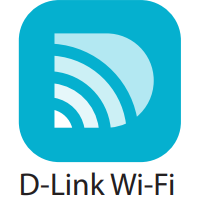
Step 3
Tap on the Install New Device button at the middle of the screen.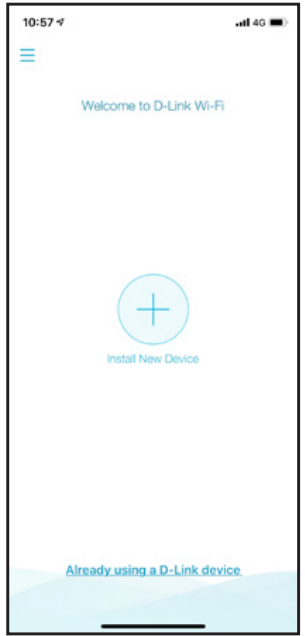
Step 4
Tap Scan the QR code to scan the setup QR code located in the Quick Installation Card and proceed to step 6. Alternatively, you can tap Continue without scanning to proceed to step 5.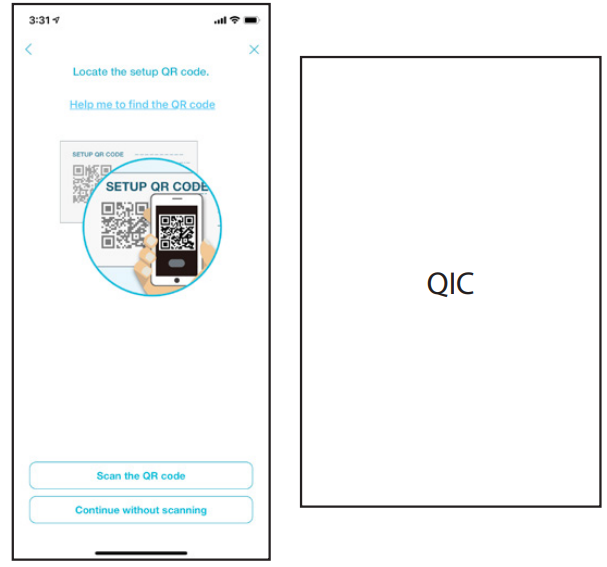
- Step 5
Select Router and select DIR-1750 from the list of available devices. Tap Next to continue. Step 6
You will now be guided through a step-by-step process for setting up your router. Simply follow the on-screen instructions to continue the installation and the configuration process.
Hardware Setup
Step 1
Position your DIR-1750 near your Internet-connected modem. Place it in an open area for better wireless coverage.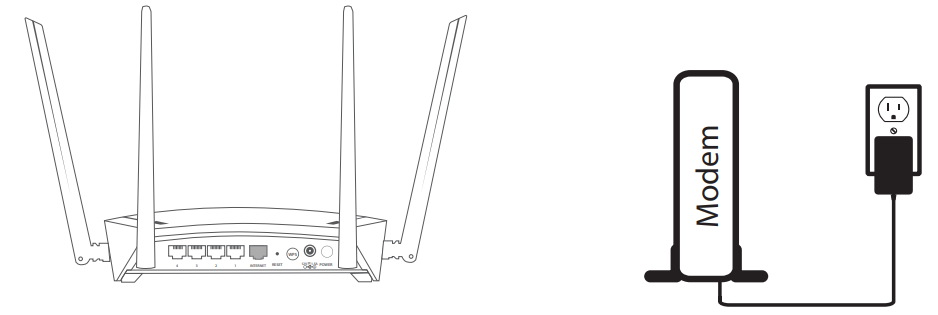
Step 2
Turn off and unplug the power to your cable or DSL broadband modem. This is required. In some cases, you may need to turn it off for up to five minutes.
Step 3
Use the Ethernet cable to connect your modem to the port labelled INTERNET on the router.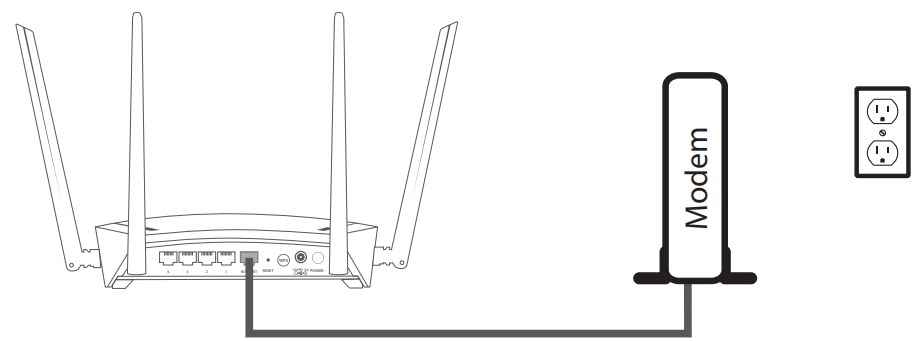
Step 4
Plug in and turn your modem back on and wait approximately one minute before proceeding.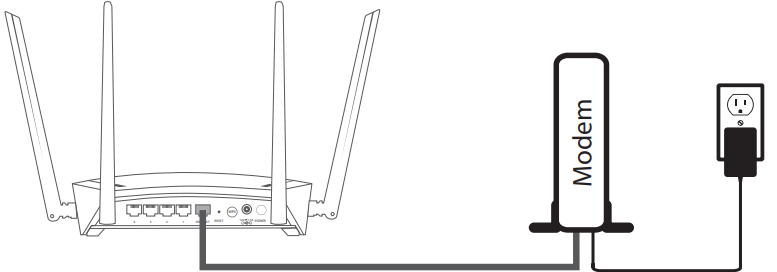
Step 5
Connect the supplied power adapter to the router and a power outlet, press the power button, and wait approximately one minute until the LED indicator on the front of the device changes from orange to solid white.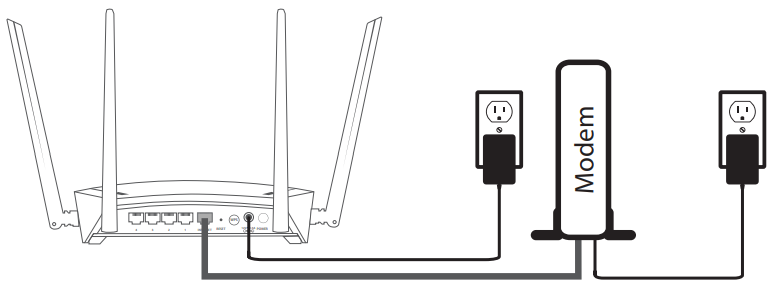
Step 6
If you are configuring the router wirelessly from a PC, connect to the Wi-Fi network printed on the label attached to the bottom of your router or in the Quick Installation Card.
If you are configuring the router from a PC with a wired Ethernet connection, plug one end of an Ethernet cable into the port labeled 1 on the back of the router, and the other end into the Ethernet port on your computer.
Step 7
If you are connecting to a broadband service that uses a dynamic connection (not PPPoE), you may be online already. Try opening a web browser and connecting to a website. If the website does not load, proceed to Setup Wizard on page 14.
Setup Wizard
The setup wizard is designed to guide you through a step-by-step process to configure your new DIR-1750 and connect to the Internet via a wireless setup process.
If this is your first time installing the router, open your web browser and enter http://dlinkrouter.local./ in the address bar. Alternatively, enter the IP address of the router (default: http://192.168.0.1).

If this is your first time logging in to the and no connection has been established, the setup wizard will automatically appear instead of the log in page. If the setup process was not previously completed, then log in to the interface by leaving the password field blank.
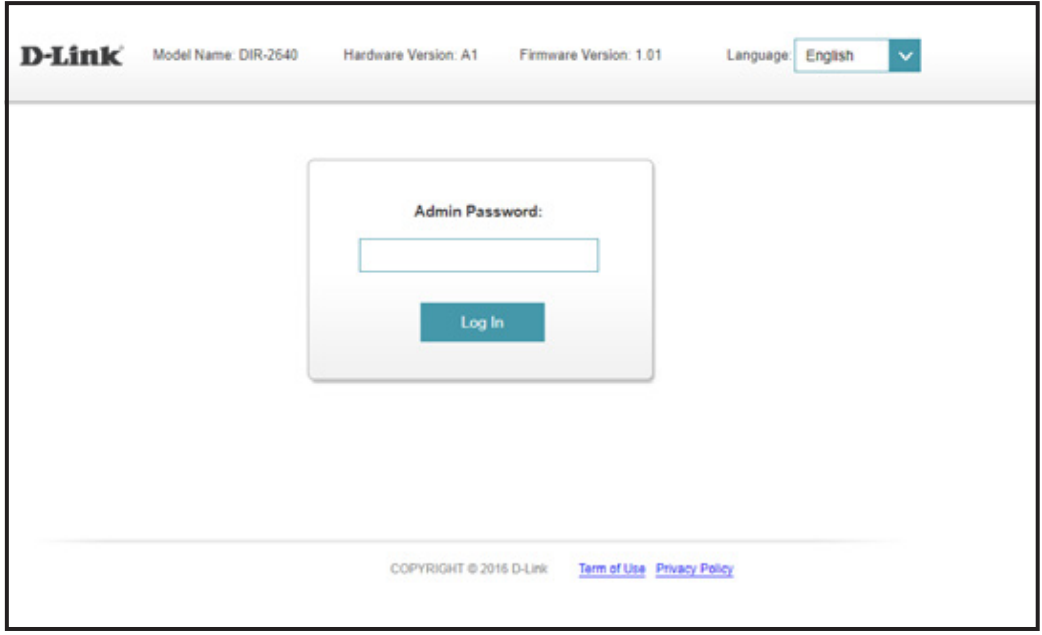
Agree to the Terms of Use and Privacy Policy before proceeding.
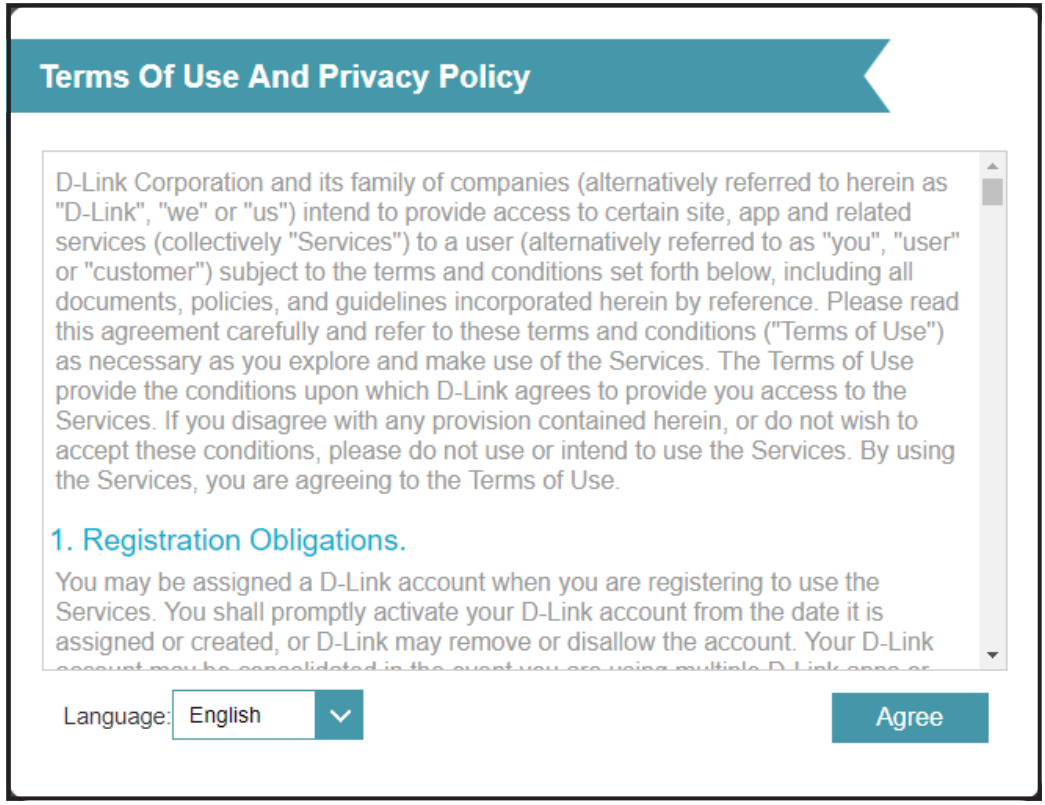
Follow the on-screen instructions to configure your new D-Link router and connect to the Internet.
Click Next to continue.
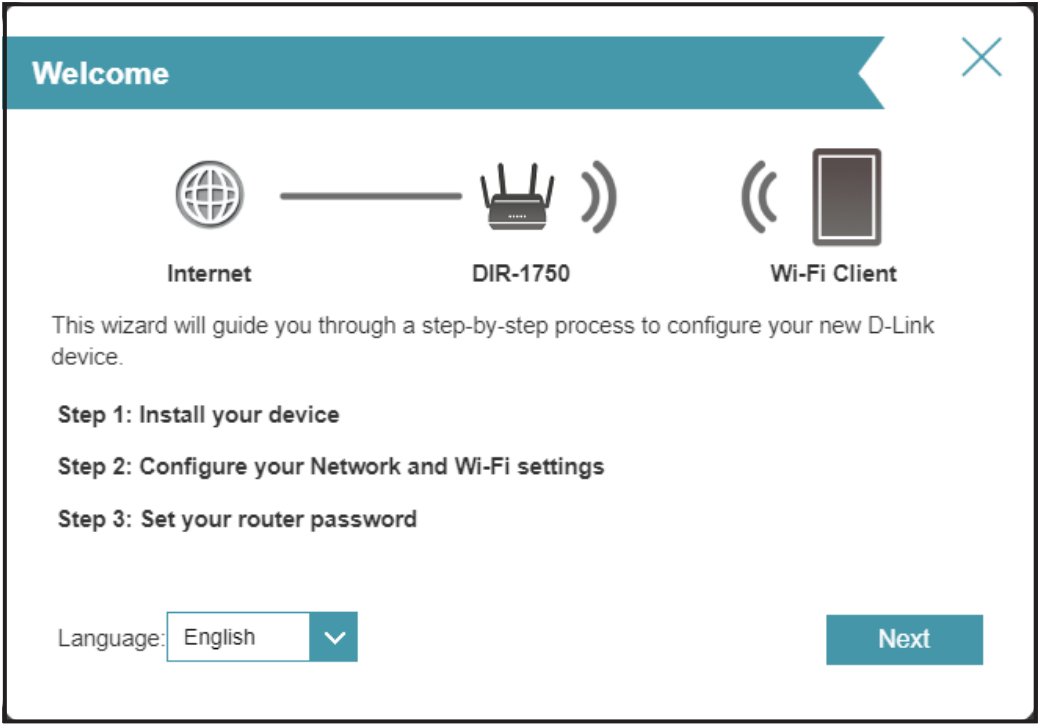
Please wait while your router detects your Internet connection type.
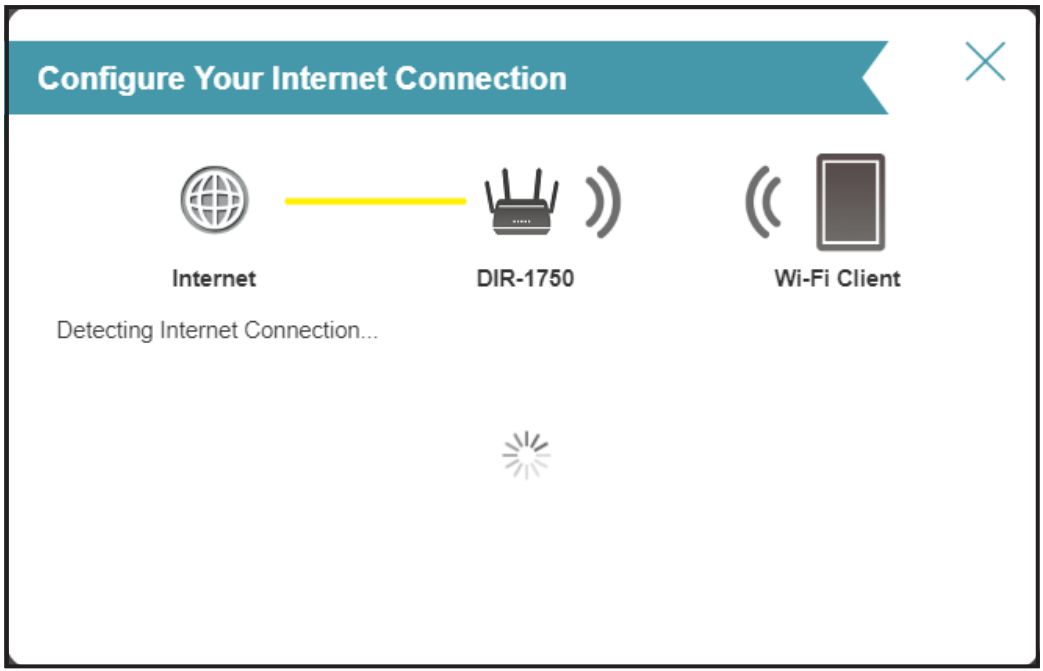
If the router does not detect a valid Internet connection, a list of connection types to choose from will be displayed. Select your Internet connection type (this information can be obtained from your Internet Service Provider).
Click Next to continue.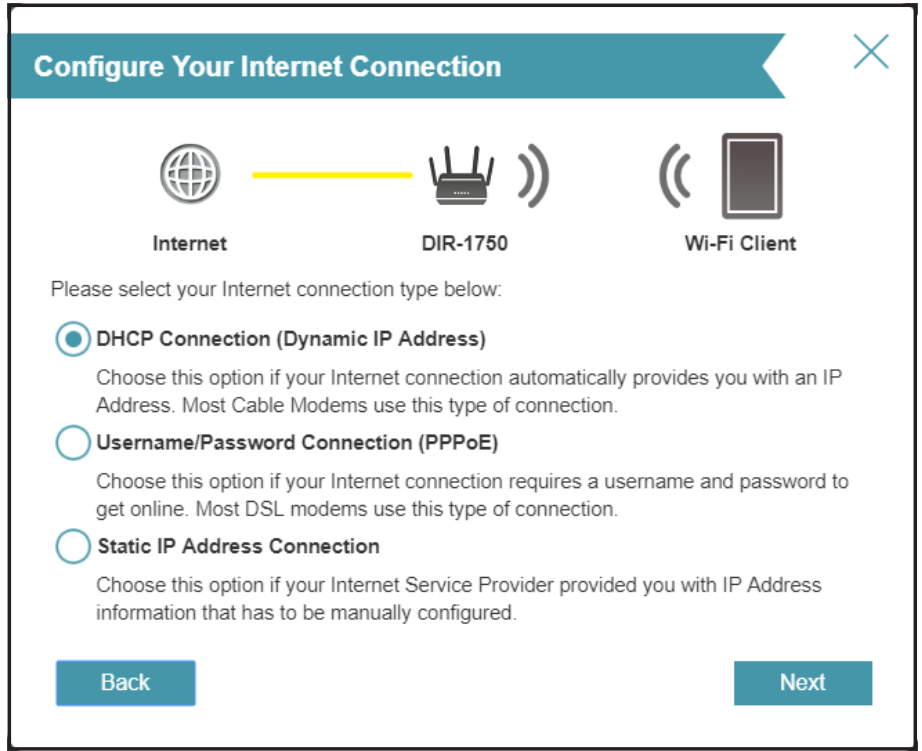
If the router detected or you selected PPPoE, enter your PPPoE username and password. If you do not have this information, please contact your ISP.
Click Next to continue.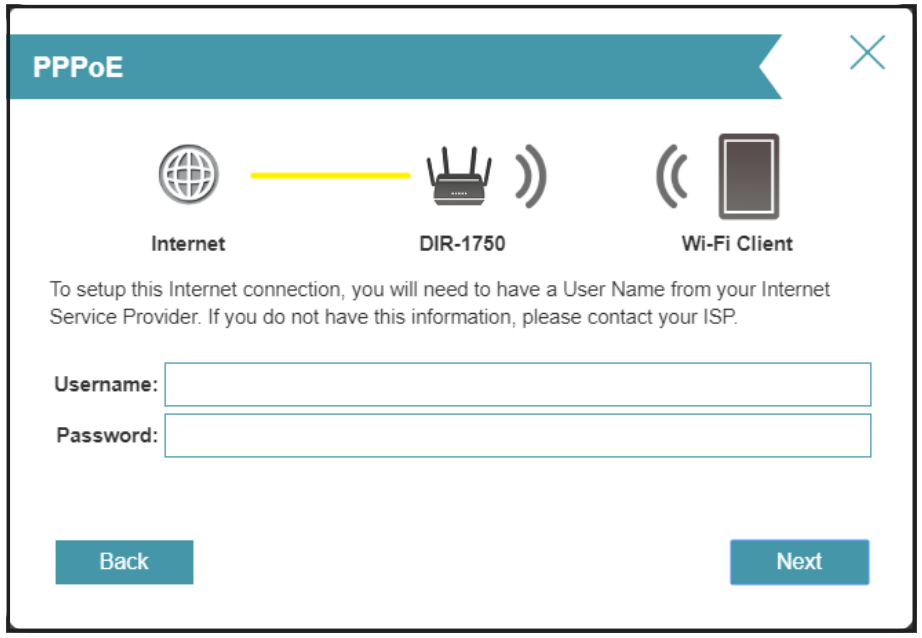
Note: Make sure to remove all other existing PPPoE software from your computer. The software is no longer needed and will not work through a router.
If the router detected or you selected Static, enter the IP and DNS settings supplied by your ISP. If you do not have this information, please contact your ISP.
Click Next to continue.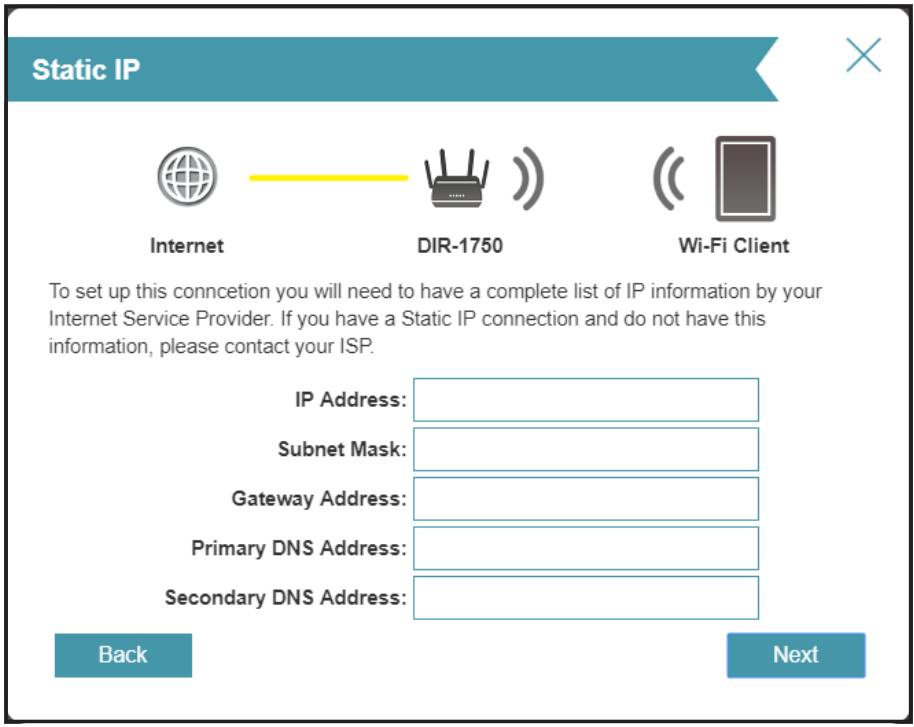
Type in a Wi-Fi Network Name and Wi-Fi Password to setup your Wi-Fi network. Your wireless clients will need to have this passphrase to be able to connect to your wireless network.
Click Next to continue.
Note: The router's Smart Connect feature presents a single wireless network. When connecting clients to an extension network, they will be automatically added to the best band, either 2.4 GHz or 5 GHz. To disable the Smart Connect feature and individually configure 2.4 GHz and 5 GHz networks,.
In order to better protect the router's configuration access, please enter a password. You will be prompted for this password every time you want to use the router’s web configuration utility.
Click Next to continue.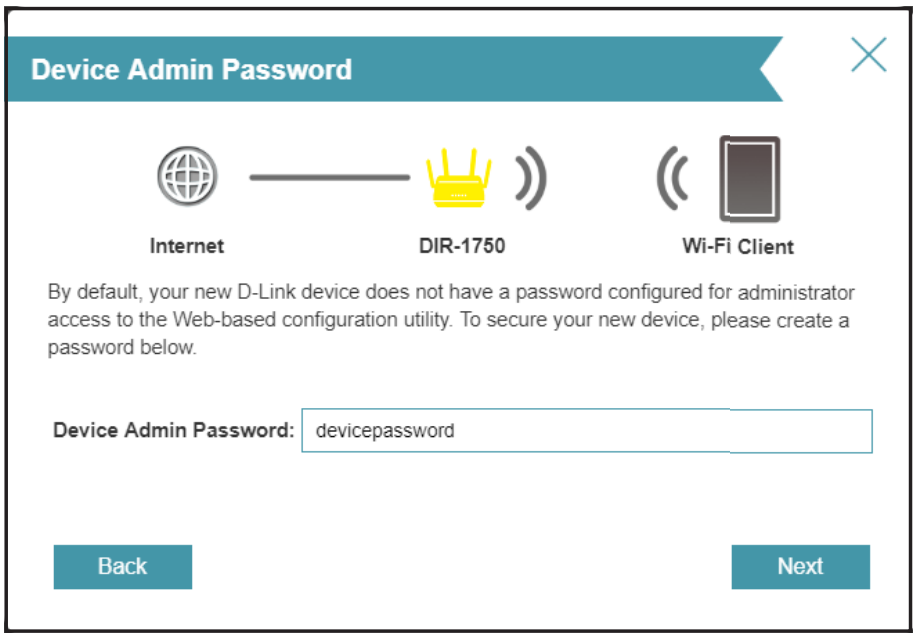
Select your time zone from the drop-down menu.
Click Next to continue.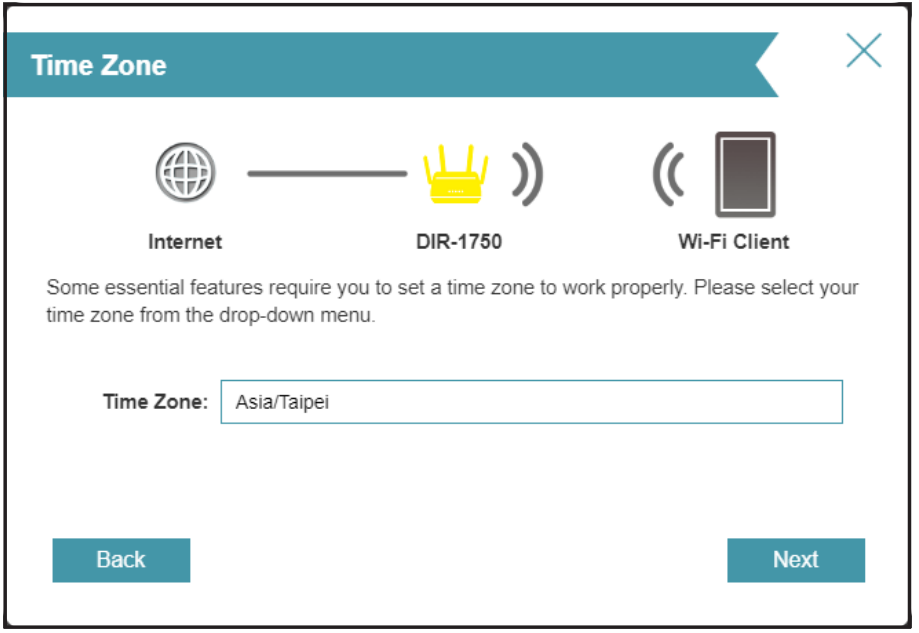
Keeping your router's firmware up-to-date provides you with the latest features over the air. Choose whether to keep your device up-to-date automatically or to manage the device updates by yourself.
Click Next to continue._(2).png)
You will be presented with a summary of your settings.
Click Next to finalize the settings or Back to make changes._(1).png)
Please wait while the device settings are saved.
Do not turn off or unplug your router during this time.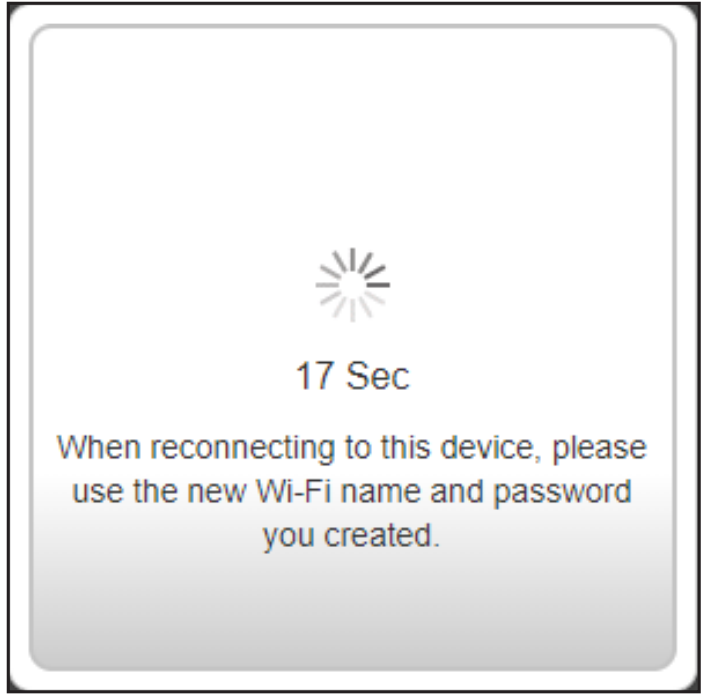
Your new settings have been saved and your router is now configured.
Click OK to close the Setup Wizard.
Congratulations, your device has been successfully configured!
You can log in to the configuration utility by inputting the Admin Password.
Setup Guide
To set up the D-Link AC1750 Wi-Fi Router DIR-1750, follow these steps:
- Connect the router to a power source and to your modem using an Ethernet cable.
- Launch a web browser and enter in the address bar to access the router's web-based setup page.
- Follow the on-screen instructions to configure the router's settings, such as wireless network name, password, and security options.
- Connect your devices to the Wi-Fi network and test the connection.
Troubleshooting
This chapter provides solutions to problems that can occur during the installation and operation of the router. Read the following descriptions if you are having problems.
Why can’t I access the web-based configuration utility?
When entering the IP address of the D-Link router (192.168.0.1 for example), you are not connecting to a website, nor do you have to be connected to the Internet. The device has the utility built-in to a ROM chip in the device itself. Your computer must be on the same IP subnet to connect to the web-based utility.
- Make sure you have an updated Java-enabled web browser. We recommend the following:
- Microsoft Internet Explorer® 10 or higher
- Mozilla Firefox 28 or higher
- Google Chrome 28 or higher
- Apple Safari 6 or higher
- Verify physical connectivity by checking for solid link lights on the device. If you do not get a solid link light, try using a different cable, or connect to a different port on the device if possible. If the computer is turned off, the link light may not be on.
- Disable any Internet security software running on the computer. Software firewalls such as ZoneAlarm, BlackICE, Sygate and Norton Personal Firewall may block access to the configuration pages. Check the help files included with your firewall software for more information on disabling or configuring it.
- Configure your Internet settings:
- Go to Start > Settings > Control Panel. Double-click the Internet Options Icon. From the Security tab, click the button to restore the settings to their defaults.
- Click the Connection tab and set the dial-up option to Never Dial a Connection. Click the LAN Settings button. Make sure nothing is checked. Click OK.
- Go to the Advanced tab and click the button to restore these settings to their defaults. Click OK three times.
- Close your web browser (if open) and open it.
- Access the web management. Open your web browser and enter the IP address of your D-Link router in the address bar. This should open the login page for your web management.
- If you still cannot access the configuration, unplug the power to the router for 10 seconds and plug back in. Wait about 30 seconds and try accessing the configuration. If you have multiple computers, try connecting using a different computer.
What can I do if I forgot my password?
If you forgot your password, you must reset your router. This process will change all your settings back to the factory defaults.
To reset the router, locate the reset button (hole) on the rear panel of the unit. With the router powered on, use a paperclip to hold the recessed button down for 10 seconds. Release the button and the router will go through its reboot process. Wait about 30 seconds to access the router. The default IP address is 192.168.0.1. When logging in, leave the password box empty.
Description
The D-Link AC1750 Wi-Fi Router DIR-1750 is a versatile and high-performance wireless router that is suitable for small to medium-sized homes and offices. Its dual-band technology ensures fast and reliable Wi-Fi connectivity, while its advanced AC Smart Beam technology improves Wi-Fi coverage and speed. The router's 4 Gigabit Ethernet ports and USB 3.0 port provide flexible connectivity options for wired devices and shared storage. The D-Link AC1750 Wi-Fi Router DIR-1750 also features advanced security features to keep your network and connected devices safe from unauthorized access and attacks.
Wireless Basics
D-Link wireless products are based on industry standards to provide easy-to-use and compatible high-speed wireless connectivity within your home, business, or public access wireless networks. Strictly adhering to the IEEE standard, the D-Link wireless family of products will allow you to access the data you want, when, and where you want it. You will be able to enjoy the freedom that wireless networking delivers.
A wireless local area network (WLAN) is a cellular computer network that transmits and receives data with radio signals instead of wires. Wireless LANs are used increasingly in both home and office environments, and public areas such as airports, coffee shops and universities. Innovative ways to utilize WLAN technology are helping people work, and communicate more efficiently. Increased mobility and the absence of cabling and other fixed infrastructure have proven to be beneficial for many users.
Wireless users can use the same applications they use on a wired network. Wireless adapter cards used on laptop and desktop systems support the same protocols as Ethernet adapter cards.
Under many circumstances, it may be desirable for mobile network devices to link to a conventional Ethernet LAN in order to use servers, printers or an Internet connection supplied through the wired LAN. A wireless router is a device used to provide this link.
What is Wireless?
Wireless or Wi-Fi technology is another way of connecting your computer to the network without using wires. Wi-Fi uses radio frequency to connect wirelessly so you have the freedom to connect computers anywhere in your home or office network.
Why D-Link Wireless?
D-Link is the worldwide leader and award winning designer, developer, and manufacturer of networking products. D-Link delivers the performance you need at a price you can afford. D-Link has all the products you need to build your network.
How does wireless work?
Wireless works similarly to how cordless phones work, through radio signals that transmit data from one point A to point B. But wireless technology has restrictions as to how you can access the network. You must be within the wireless network range area to be able to connect your computer. There are two different types of wireless networks: Wireless Local Area Network (WLAN), and Wireless Personal Area Network (WPAN).
Wireless Local Area Network (WLAN)
In a wireless local area network, a device called an Access Point (AP) connects computers to the network. The access point has a small antenna attached to it, which allows it to transmit data back and forth over radio signals. With an indoor access point the signal can travel up to 300 feet. With an outdoor access point the signal can reach out up to 30 miles to serve places like manufacturing plants, industrial locations, university and high school campuses, airports, golf courses, and many other outdoor venues.
Wireless Personal Area Network (WPAN)
Bluetooth is the industry standard wireless technology used for WPAN. Bluetooth devices in WPAN operate in a range up to 30 feet away. Compared to WLAN the speed and wireless operation range are both less than WLAN, but in return it doesn’t use nearly as much power. This makes it ideal for personal devices, such as mobile phones, PDAs, headphones, laptops, speakers, and other devices that operate on batteries.
Who uses wireless?
Wireless technology as become so popular in recent years that almost everyone is using it, whether it’s for home, office, business, D-Link has a wireless solution for it.
Home Uses/Benefits
- Gives everyone at home broadband access
- Surf the web, check email, instant message, etc.
- Gets rid of the cables around the house
- Simple and easy to use
Small Office and Home Office Uses/Benefits
- Stay on top of everything at home as you would at office
- Remotely access your office network from home
- Share Internet connection and printer with multiple computers
- No need to dedicate office space
Where is wireless used?
Wireless technology is expanding everywhere, not just at home or office. People like the freedom of mobility and it’s becoming so popular that more and more public facilities now provide wireless access to attract people. The wireless connection in public places is usually called “hotspots”. Using a D-Link USB adapter with your laptop, you can access the hotspot to connect to the Internet from remote locations like: airports, hotels, coffee shops, libraries, restaurants, and convention centers. Wireless network is easy to setup, but if you’re installing it for the first time it could be quite a task not knowing where to start. That’s why we’ve put together a few setup steps and tips to help you through the process of setting up a wireless network.
Tips
Here are a few things to keep in mind, when you install a wireless network.
Centralize your router or access point
Make sure you place the router/access point in a centralized location within your network for the best performance. Try to place the router/access point as high as possible in the room, so the signal gets dispersed throughout your home. If you have a two-story home, you may need a repeater to boost the signal to extend the range.
Eliminate Interference
Place home appliances such as cordless telephones, microwaves, and televisions as far away as possible from the router/access point. This would significantly reduce any interference that the appliances might cause since they operate on same frequency.
Wireless Modes
There are basically two modes of networking:
- Infrastructure – All wireless clients will connect to an access point or wireless router.
- Ad-hoc – Directly connecting to another computer for peer-to-peer communication using wireless network adapters on each computer, such as two or more wireless network USB adapters.
An Infrastructure network contains an access point or wireless router. All the wireless devices, or clients, will connect to the wireless router or access point.
An Ad-hoc network contains only clients, such as laptops with wireless USB adapters. All the adapters must be in Ad-hoc mode to communicate.
Networking Basics
Check your IP address
- After you install your new D-Link adapter, by default, the TCP/IP settings should be set to obtain an IP address from a DHCP server (i.e. wireless router) automatically. To verify your IP address, please follow the steps below.
- Click on Start > Run. In the run box type cmd and click OK. (Windows® 7/Vista® users type cmd in the Start Search box.)
- At the prompt, type ipconfig and press Enter.
- This will display the IP address, subnet mask, and the default gateway of your adapter.
If the address is 0.0.0.0, check your adapter installation, security settings, and the settings on your router. Some firewall software programs may block a DHCP request on newly installed adapters.
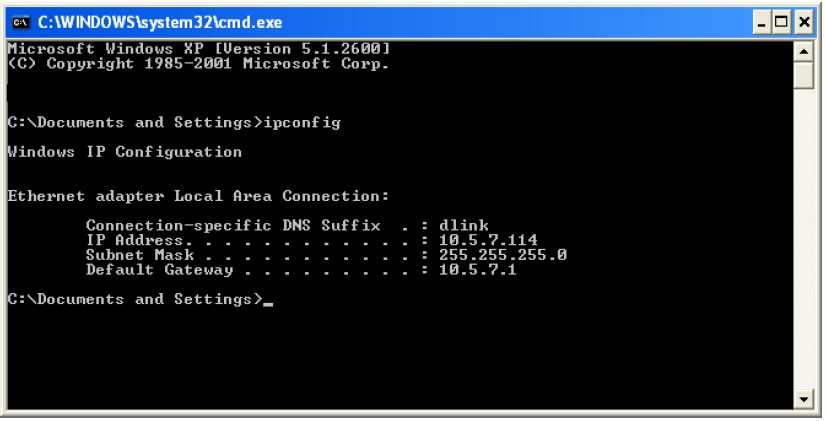
Statically Assign an IP Address
- If you are not using a DHCP capable gateway/router, or you need to assign a static IP address, please follow the steps below:
- Windows 7: Start > Control Panel > Network and Internet > Network and Sharing Center
- Windows Vista: Start > Control Panel > Network and Internet > Network and Sharing Center > Manage Network Connections
- Windows XP: Start > Control Panel > Network Connections
- Windows 2000: From the desktop, right-click My Network Places > Properties
- Right-click on the Local Area Connection which represents your network adapter and select Properties.
- Highlight Internet Protocol (TCP/IP) and click Properties.
- Click Use the following IP address and enter an IP address that is on the same subnet as your network or the LAN IP address on your router.
- Example: If the router’s LAN IP address is 192.168.0.1, make your IP address 192.168.0.X where X is a number between 2 and 99. Make sure that the number you choose is not in use on the network.
- Set the Default Gateway the same as the LAN IP address of your router (i.e., 192.168.0.1).
- Set the Primary DNS the same as the LAN IP address of your router (192.168.0.1). The Secondary DNS is not needed or you may enter a DNS server from your ISP.
Click OK twice to save your settings.
Wireless Security
This section will show you the different levels of encryption you can use to better protect your data from intruders. The router offers the following types:
- WPA2 (Wi-Fi Protected Access 2)
- WPA (Wi-Fi Protected Access)
- WPA2-PSK (Pre-Shared Key)
- WPA-PSK (Pre-Shared Key)
What is WPA?
WPA (Wi-Fi Protected Access), is a Wi-Fi standard that was designed to improve the security features of WEP (Wired Equivalent Privacy).
The 2 major improvements over WEP:
- Improved data encryption through the Temporal Key Integrity Protocol (TKIP). TKIP scrambles the keys using a hashing algorithm and by adding an integrity-checking feature, ensures that the keys haven’t been tampered with. WPA2 is based on 802.11i and uses Advanced Encryption Standard (AES) instead of TKIP.
- User authentication, which is generally missing in WEP, through the extensible authentication protocol (EAP). WEP regulates access to a wireless network based on a computer’s hardware-specific MAC address, which is relatively simple to be sniffed out and stolen. EAP is built on a more secure public-key encryption system to ensure that only authorized network users can access the network.
WPA-PSK/WPA2-PSK uses a passphrase or key to authenticate your wireless connection. The key is an alpha-numeric password between 8 and 63 characters long. The password can include symbols (!?*&_) and spaces. This key must be the exact same key entered on your wireless router or access point.
WPA/WPA2 incorporates user authentication through the Extensible Authentication Protocol (EAP). EAP is built on a more secure public key encryption system to ensure that only authorized network users can access the network.
Pros & Cons
Pros:
- Fast and reliable dual-band Wi-Fi connectivity
- Advanced AC Smart Beam technology for improved Wi-Fi coverage and speed
- Flexible connectivity options with 4 Gigabit Ethernet ports and USB 3.0 port
- Advanced security features to keep your network and devices safe
Cons:
- May not be suitable for larger homes or offices with more extensive Wi-Fi coverage needs
- Some users may find the web-based setup interface to be confusing or intimidating
Faqs
What is the maximum data transfer rate of the D-Link AC1750 Wi-Fi Router DIR-1750?
How many Gigabit Ethernet ports does the D-Link AC1750 Wi-Fi Router DIR-1750 have?
What security features does the D-Link AC1750 Wi-Fi Router DIR-1750 have?
How do I access the web-based setup page of the Wi-Fi Router DIR-1750?
How do I update the firmware of the D-Link AC1750 Wi-Fi Router DIR-1750?
What should I do if I can't connect to the Wi-Fi network of the D-Link AC1750 Wi-Fi?
Can I use the D-Link AC1750 Wi-Fi Router DIR-1750 for a large home or office with extensive Wi-Fi coverage needs?
How do I reset the D-Link AC1750 Wi-Fi Router to its factory settings?
Leave a Comment
